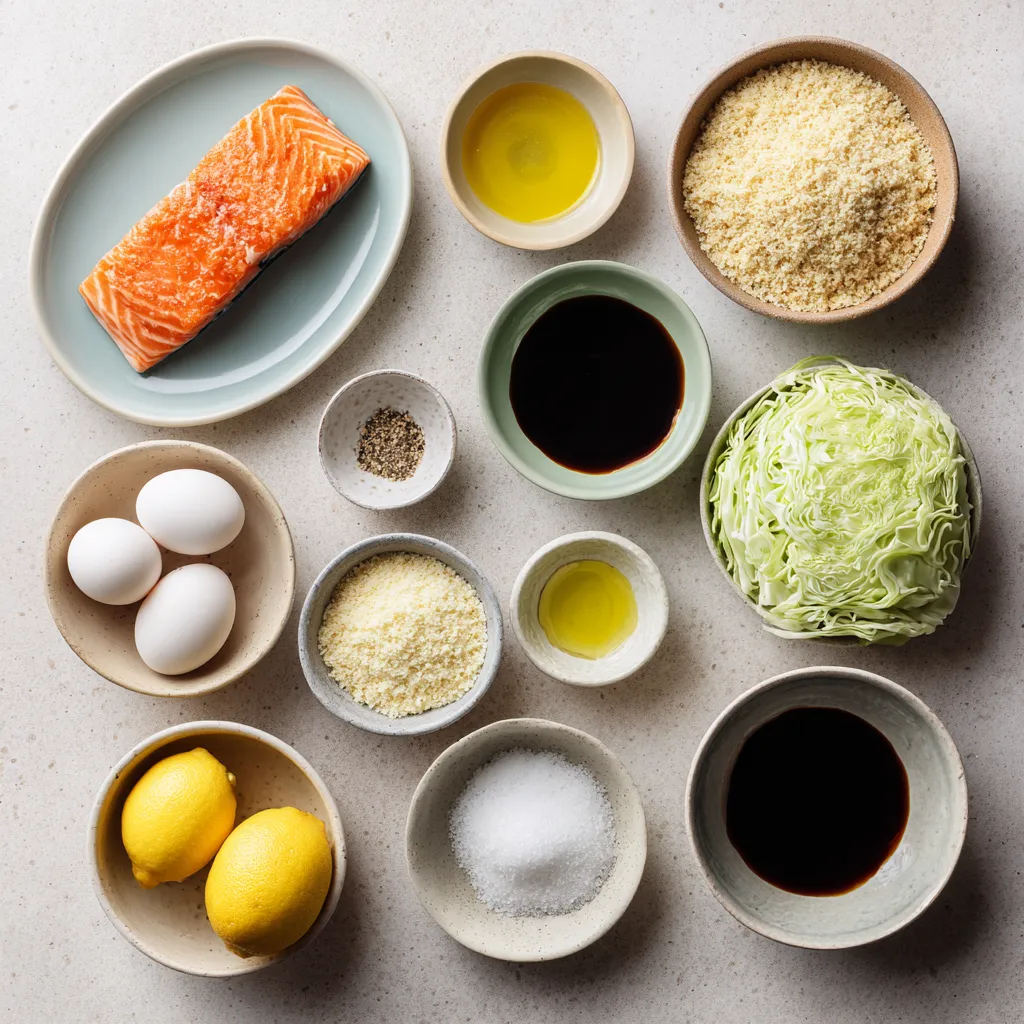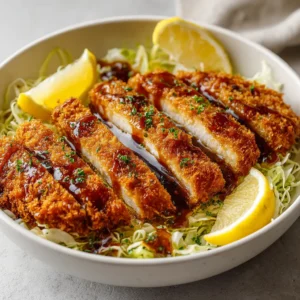Introduction
Salmon Katsu Delight is an enticing fusion dish that combines the richness of perfectly cooked salmon with the crispy, satisfying texture of traditional katsu. The marriage of these elements creates a dish that is not only delicious but also visually stunning, making it an excellent choice for various occasions—from casual family dinners to celebratory gatherings. The contrasting flavors of the flaky salmon, complemented by the crunch of panko breadcrumbs, provide a delightful experience for the palate.
In this article, you will discover how to create this gourmet meal step by step. We will delve into the essential techniques needed to prepare the salmon, bread it perfectly, and fry it to golden perfection. Additionally, you will learn about the garnishing tips and serving suggestions that can elevate your Salmon Katsu Delight, ensuring that it is as appealing to the eyes as it is to the taste buds.
Recipe Overview
– Total Time: 30 minutes
– Prep Time: 15 minutes
– Cook Time: 15 minutes
– Yield/Servings: 2
– Difficulty: Not specified in the recipe
This dish features succulent salmon fillets coated with breadcrumbs. Each bite is guaranteed to deliver a crunchy outer layer while keeping the fish tender and flavorful. The presentation is equally impressive, as it is served over a bed of shredded cabbage, enriched by a drizzle of tonkatsu sauce and garnished with fresh lemon wedges. This culinary masterpiece is ideal for anyone looking to impress their guests or simply to treat themselves to a special meal.
Ingredients
To create this delectable Salmon Katsu Delight, you will need the following ingredients:
– 2 large skinless, boneless salmon fillets
– 1 cup panko breadcrumbs
– 1/2 cup all-purpose flour
– 2 large eggs
– 1 tablespoon soy sauce
– 1 tablespoon sesame oil
– Salt and freshly cracked black pepper, to taste
– Vegetable oil, for frying
– 1 cup shredded cabbage (for garnish)
– Fresh lemon wedges (for garnish)
– Tonkatsu sauce (for serving)
Each ingredient in this recipe serves a purpose, enhancing the overall flavor and texture of the dish. The panko breadcrumbs are key to achieving that crunchy texture unique to katsu, while the soy sauce and sesame oil add depth and a hint of umami that elevates the salmon’s natural richness.

Instructions
To get started on your Salmon Katsu Delight, follow these detailed steps:
1. Prepare the Salmon: Begin by generously seasoning the salmon fillets with salt and freshly cracked black pepper. If desired, you can cut the fillets into smaller portions for more manageable bites, ensuring each piece is evenly seasoned.
2. Set Up Your Breading Station: Arrange three shallow bowls for the breading process. Place all-purpose flour in the first bowl, whisk together the eggs with soy sauce and sesame oil until smooth in the second bowl, and fill the third bowl with panko breadcrumbs.
3. Bread the Salmon: Take each salmon piece and dredge it in the flour, shaking off any excess before proceeding. Next, dip the floured salmon into the egg mixture, allowing any surplus to drip off. Finally, generously coat the salmon with panko breadcrumbs, gently pressing them onto the fish to ensure they adhere well.
4. Heat the Oil: In a large skillet, pour enough vegetable oil to cover the bottom by approximately 1/4 inch. Heat the oil over medium heat. To test if the oil is ready, sprinkle a few breadcrumbs into it; they should sizzle vigorously upon contact.
5. Fry the Salmon: Carefully place the breaded salmon pieces into the hot oil. Fry them in batches if necessary to avoid overcrowding the pan. Cook for about 3-4 minutes on each side, or until the salmon is golden brown and cooked through. Once done, transfer the fillets to a plate lined with paper towels to absorb any excess oil.
6. Serve: For an inviting presentation, slice the katsu into strips and arrange them over a bed of shredded cabbage. Drizzle generously with tonkatsu sauce and decorate your plate with fresh lemon wedges for a vibrant finish.
– Presentation Tips: To enhance the visual appeal, consider serving the salmon katsu on a colorful plate or in a bento box. A sprinkle of sesame seeds and a few slices of cucumber can further accentuate the dish, making it more attractive.
Preparing the Salmon
Before frying your Salmon Katsu Delight, the key to achieving a flavorful dish lies in properly preparing the salmon fillets.
Seasoning Steps
The first step involves seasoning the salmon thoroughly with salt and freshly cracked black pepper. This simple process amplifies the flavor and ensures that each bite is full of taste. Furthermore, if you prefer, consider cutting the salmon fillets into smaller, bite-sized pieces before seasoning. This not only makes the salmon easier to handle but also allows for a quicker cooking time.
Fish Handling Tips
To ensure a clean and precise portioning of the salmon, use a sharp knife for cutting. This will provide cleaner edges, maintaining the fillet’s integrity. It is also advisable to ensure that the salmon fillets are dry before seasoning them. This promotes better adherence of the coating during the breading process, leading to an even crispier finish post-frying.
Setting Up Your Breading Station
Creating an efficient workspace is crucial when preparing your Salmon Katsu Delight.
Required Bowls
To facilitate the breading process, prepare three shallow bowls: one for all-purpose flour, another for the egg mixture, and the third for panko breadcrumbs. Having them arranged in this manner will streamline the assembly line process, making handling the salmon more efficient and less messy.
Egg Mixture Preparation
In the second bowl, combine the eggs with soy sauce and sesame oil. Whisk these ingredients together until the mixture is smooth and homogenous. This egg wash will not only impart flavor but will also help the panko breadcrumbs adhere to the salmon as you bread it, contributing to the satisfying crunch that is a hallmark of katsu dishes.
Bread the Salmon
This step is essential in transforming seasoned salmon into the burger with its coveted katsu crust.
Dredging Process
Begin the breading process by coating each salmon fillet with all-purpose flour. This initial step forms the base layer for the katsu coating and helps the egg mixture stick effectively, so make sure to shake off any excess flour.
Egg Coating
Next, dip the floured salmon into the egg mixture, allowing any surplus liquid to drip off before moving on to the breadcrumbs. This ensures that only an even layer of mixture is left on the salmon, allowing it to achieve that perfect crispy finish once fried.
Final Coating
Finally, generously coat the salmon with panko breadcrumbs, gently pressing them onto the fish to ensure they adhere well. This crucial step will create the crunchy texture that defines traditional katsu, offering a delightful contrast to the tender salmon fillets beneath.
{{image_4}}
occasions.
Heating the Oil
The oil temperature is crucial for achieving the perfect fry on the salmon katsu. It’s essential to use the right amount of oil and to heat it adequately for optimal cooking results.
Choosing the Right Pan
A large skillet is ideal for frying salmon katsu, as it provides ample space to ensure that each piece can fry evenly without sticking together. A non-stick skillet can also work, but a seasoned cast iron or stainless steel skillet will yield a better crust due to superior heat retention and browning capabilities.
Oil Temperature Test
Before adding the salmon, it’s important to check that the oil is hot enough for frying. A simple way to test its readiness is by sprinkling a few panko breadcrumbs into the oil. They should sizzle vigorously upon contact; if they don’t, allow the oil to heat for a little longer, as insufficiently heated oil will result in greasy, soggy katsu.
Frying the Salmon
Executing the frying step correctly is key to achieving a crunchy texture while ensuring the fish is cooked through without being dry.
Frying Technique
Carefully place the breaded salmon into the hot oil, ensuring to do so away from you to avoid splattering. Place in the skillet without overcrowding; instead, fry in batches if necessary—overcrowding leads to a drop in oil temperature, which can prevent proper browning.
Cooking Time
Fry each side of the salmon for approximately 3-4 minutes, keeping an eye on the color and texture. The salmon is done when it reaches a golden brown crust. Use a spatula to check for doneness; the salmon should flake easily, indicating that it is cooked through.
Draining Excess Oil
Once cooked, carefully transfer the salmon to a plate lined with paper towels. This step is crucial as it absorbs any excess oil, preventing the katsu from becoming too greasy while ensuring a crispy finish.
Serving the Salmon Katsu
Presentation is key to enhancing the dining experience, and it’s easy to make this dish visually appealing with a few tips.
Plating Suggestions
For an elegant presentation, slice the katsu into strips. This not only makes it easier for guests to enjoy but also allows the beautiful golden crust to be showcased. Arrange the salmon strips over a bed of vibrant shredded cabbage, which adds a refreshing crunch and color contrast to the dish.
Garnishment
Drizzle the salmon katsu generously with tonkatsu sauce. The rich, tangy flavor of the sauce complements the savory salmon and crispy panko beautifully. Fresh lemon wedges served on the side not only enhance the dish’s visual appeal but also add a zesty brightness that cuts through the richness.
Presentation Tips
Enhancing the visual appeal of your dish can make all the difference in how it is received by your guests.
Decorative Elements
Consider adding a sprinkle of sesame seeds over the top of the salmon katsu for an extra touch of flavor and texture. Slices of cucumber can also be arranged around the dish as a refreshing accompaniment, providing a lovely contrast to the crispy salmon.
Choosing the Right Dishware
Opt for colorful plates or a bento box presentation to elevate the dish. Using vibrant dishware draws attention to the beautiful colors of the food and creates an inviting dining atmosphere.
Nutritional Value
Understanding the health benefits of the ingredients in salmon katsu can enhance appreciation for the dish.
Salmon Benefits
Salmon is celebrated for its high omega-3 fatty acid content, which is known to be beneficial for heart health, brain function, and reducing inflammation in the body. It is also a good source of high-quality protein, essential for muscle maintenance and overall health.
Nutritional Balance
Salmon katsu provides a balanced dish containing protein from the fish, carbohydrates from the panko and flour, and healthy fats from the frying oil. The addition of shredded cabbage lends dietary fiber and vitamins, making this dish both satisfying and nutritious.
Cooking Timing
Understanding the total time investment for preparing salmon katsu helps in planning your meal effectively.
Preparation vs. Cooking Time
The total time from prep to serving is about 30 minutes. The prep time is approximately 15 minutes, allowing for seasoning, breading, and oil heating. The actual cooking, with the frying of the salmon, takes around 10-15 minutes, depending on how quickly you can fry in batches.
Speeding Up the Process
To maximize efficiency, consider multitasking during the prep work. While you’re breading the salmon, you can heat the oil in a separate skillet. This way, as you finish each piece, the oil should be ready, allowing you to place the salmon directly into the skillet without waiting.
Conclusion
Salmon Katsu Delight offers a harmonious blend of textures, where the crispiness of the panko coating perfectly complements the rich salmon. The dish can be prepared in about 30 minutes, making it ideal for both casual dinners and special occasions. The visual appeal and nutritional benefits enhance the overall dining experience, ensuring satisfaction with every bite.


